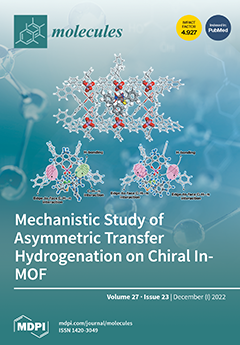As a major public health problem, the prevalence of
Acinetobacter baumannii (
A. baumannii) infections in hospitals due to the pathogen’s multiple-antibiotic resistance has attracted extensive attention. We previously reported a series of 1,3-diamino-7H-pyrrolo[3,2-f]quinazoline (PQZ) compounds, which were designed by targeting
Escherichia
[...] Read more.
As a major public health problem, the prevalence of
Acinetobacter baumannii (
A. baumannii) infections in hospitals due to the pathogen’s multiple-antibiotic resistance has attracted extensive attention. We previously reported a series of 1,3-diamino-7H-pyrrolo[3,2-f]quinazoline (PQZ) compounds, which were designed by targeting
Escherichia coli dihydrofolate reductase (
ecDHFR), and exhibited potent antibacterial activities. In the current study, based on our molecular-modeling study, it was proposed that PQZ compounds may function as potent
A. baumannii DHFR (
abDHFR)-inhibitors as well, which inspired us to consider their anti-
A. baumannii abilities. We further found that three PQZ compounds, OYYF-171, -172, and -175, showed significant antibacterial activities against
A. baumannii, including multidrug-resistant (MDR) strains, which are significantly stronger than the typical DHFR-inhibitor, trimethoprim (TMP), and superior to, or comparable to, the other tested antibacterial agents belonging to β-lactam, aminoglycoside, and quinolone. The significant synergistic effect between the representative compound OYYF-171 and the dihydropteroate synthase (DHPS)-inhibitor sulfamethoxazole (SMZ) was observed in both the microdilution-checkerboard assay and time-killing assay, which indicated that using SMZ in combination with PQZ compounds could help to reduce the required dosage and forestall resistance. Our study shows that PQZ is a promising scaffold for the further development of folate-metabolism inhibitors against MDR
A. baumannii.
Full article






